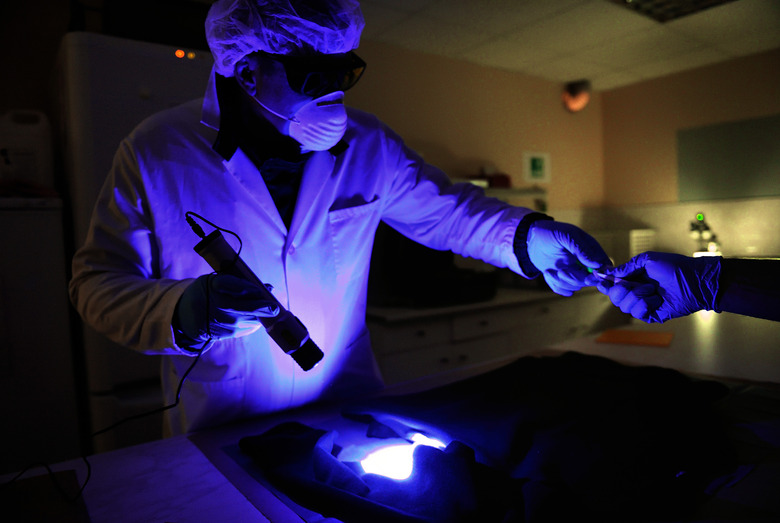Can You Use A Blacklight To Search For Bacteria In Your Home?
Also known as long-wave ultraviolet light (or UVA light), blacklight causes specific materials to "fluoresce" or radiate visible light in total darkness. This essentially means that when put under UVA light, the material will glow. According to Horiba Scientific, a company that provides scientific instruments, bodily fluids such saliva, semen, and vaginal fluid will fluoresce and can thus be detected under blacklight. That would explain why you might see a blacklight being used on your favorite show depicting crime scene investigations.
Since certain bodily fluids can transmit certain sickness-causing bacteria and viruses, a blacklight can also help you detect potentially threatening bodily fluids. However, the blacklight should not be seen as a detector that specifically illuminates bacteria and viruses — it only illuminates fluorescent bodily fluids that can potentially contain said bacteria and viruses. There is no way of knowing if the fluids do contain bacteria and viruses by using a black light.
Dr. Eric Lee — who is a medical director of several nursing homes, works in the ER, and is a medical expert for InvigorMedical.com — tells Hunker, "I would not use a blacklight to search for bacteria, because black lights do not disclose the presence of bacteria. I do not believe that it is in the best interests of a person to 'search for bacteria.' This implies that the person would try to eradicate the bacteria on a regular basis, which is simply not necessary for most people."
When it comes to the topical coronavirus (COVID-19), Dr. Shuhan He — an Emergency Medicine physician at the Harvard Teaching Hospital Affiliate Massachusetts General Hospital — tells Hunker that a blacklight would not be able to isolate and distinguish the virus specifically. "Coronavirus is a very small virus that can't be visualized unless you use advanced electron microscopy," he says.
According to the CDC, there is also not enough information to conclude which bodily fluids, other than respiratory fluid, specifically transmit the coronavirus. The CDC states, "Very limited data are available about detection of SARS-CoV-2 [the virus that causes COVID-19] and infectious virus in clinical specimens [which can include bodily fluids]." The CDC adds that it is not yet known if viable, infectious SARS-CoV-2 can be found in nonrespiratory body fluids like urine, semen, vomit, and breast milk. The organization states the the coronavirus is mainly spread from person to person, via respiratory droplets produced when one coughs or sneezes. However, under the section on infected surfaces and objects, the CDC writes, "It may be possible that a person can get COVID-19 by touching a surface or object that has the virus on it and then touching their own mouth, nose, or possibly their eyes, but this is not thought to be the main way the virus spreads."
Taking the blacklight's properties, expert advice, and the CDC's coronavirus information into account, a blacklight should not be seen as a method to specifically detect coronavirus. It can help you detect bodily fluids that might contain the coronavirus, but again, there is limited data pointing to exactly which fluids do so in the first place. In other words, you can use a blacklight to help you disinfect surfaces to prevent the overall spread of disease, but if you believe you have been exposed to the coronavirus, you should contact a healthcare provider as soon as possible. According to the CDC, it can then work with your state and local health departments to get you tested using the CDC's diagnostic test.
To summarize: A blacklight cannot identify bacteria in your home. All it will do is show you traces of bodily fluids.
